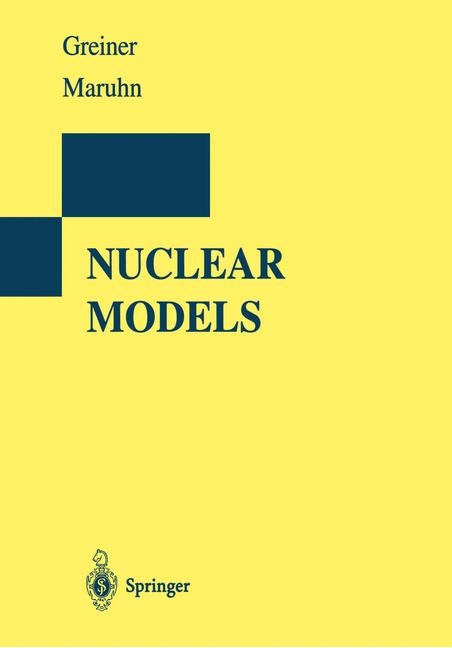
Nuclear Models
Springer Berlin (Verlag)
978-3-540-78046-5 (ISBN)
- Titel ist leider vergriffen;
keine Neuauflage - Artikel merken
Prof. Dr. rer. nat. Dr. h. c. mult. Walter Greiner, geb. Oktober 1935 im Thüringer Wald, Promotion 1961 in Freiburg im Breisgau, 1962-64 Assistent Professor an der University of Maryland, seit 1964/65 ordentlicher Professor für Theoretische Physik der Johann Wolfgang Goethe-Universität Frankfurt am Main und Direktor des Instituts für Theoretische Physik. Gastprofessuren unter anderem an der Florida State University, University of Virginia, Los Alamos Scientific Laboratory, University of California Berkeley, Oak Ridge National Laboratory, University of Melbourne, Yale University, Vanderbilt University, University of Arizona. Hauptarbeitsgebiete sind die Struktur und Dynamik der elementaren Materie (Quarks, Gluonen, Mesonen, Baryonen, Atomkerne), Schwerionenphysik, Feldtheorie (Quantenelektrodynamik, Eichtheorie der schwachen Wechselwirkung, Quantenchromodynamik, Theorie der Gravitation), Atomphysik. 974 Empfänger des Max-Born-Preises und der Max-Born-Medaille des Institute of Physics (London) und der Deutsche Physikalische Gesellschaft, 1982 des Otto-Hahn-Preises der Stadt Frankfurt am Main, 1998 der Alexander von Humboldt-Medaille, 1999 Officier dans l'Ordre des Palmes Academiques. Inhaber zahlreicher Ehrendoktorwürden (unter anderem der University of Witwatersrand, Johannesburg, der Universite Louis Pasteur Strasbourg, der UNAM Mexico, der Universitäten Bucharest, Tel Aviv, Nantes, St. Petersburg, Moskau, Debrecen, Dubna und anderen) sowie Ehrenprofessuren (University of Bejing, China, und Jilin University Changchun, China) und Ehrenmitglied vieler Akademien.
1. Introduction.- 1.1 Nuclear Structure Physics.- 1.2 The Basic Equation.- 1.3 Microscopic versus Collective Models.- 1.4 The Role of Symmetries.- 2. Symmetries.- 2.1 General Remarks.- 2.2 Translation.- 2.2.1 The Operator for Translation.- 2.2.2 Translational Invariance.- 2.2.3 Many-Particle Systems.- 2.3 Rotation.- 2.3.1 The Angular Momentum Operators.- 2.3.2 Representations of the Rotation Group.- 2.3.3 The Rotation Matrices.- 2.3.4 SU(2) and Spin.- 2.3.5 Coupling of Angular Momenta.- 2.3.6 Intrinsic Angular Momentum.- 2.3.7 Tensor Operators.- 2.3.8 The Wigner-Eckart Theorem.- 2.3.9 6j and 9j Symbols.- 2.4 Isospin.- 2.5 Parity.- 2.5.1 Definition.- 2.5.2 Vector Fields.- 2.6 Time Reversal.- 3. Second Quantization.- 3.1 General Formalism.- 3.1.1 Motivation.- 3.1.2 Second Quantization for Bosons.- 3.1.3 Second Quantization for Fermions.- 3.2 Representation of Operators.- 3.2.1 One-Particle Operators.- 3.2.2 Two-Particle Operators.- 3.3 Evaluation of Matrix Element for Fermions.- 3.4 The Particle-Hole Picture.- 4. Group Theory in Nuclear Physics.- 4.1 Lie Groups and Lie Algebras.- 4.2 Group Chains.- 4.3 Lie Algebras in Second Quantization.- 5. Electromagnetic Moments and Transitions.- 5.1 Introduction.- 5.2 The Quantized Electromagnetic Field.- 5.3 Radiation Fields of Good Angular Momentum.- 5.3.1 Solutions of the Scalar Helmholtz Equation.- 5.3.2 Solutions of the Vector Helmholtz Equation.- 5.3.3 Properties of the Multipole Fields.- 5.3.4 Multipole Expansion of Plane Waves.- 5.4 Coupling of Radiation and Matter.- 5.4.1 Basic Matrix Elements.- 5.4.2 Multipole Expansion of the Matrix Elements and Selection Rules.- 5.4.3 Siegert s Theorem.- 5.4.4 Matrix Elements for Emission in the Long-Wavelength Limit.- 5.4.5 Relative Importance of Transitions and Weisskopf Estimates.- 5.4.6 Electric Multipole Moments.- 5.4.7 Effective Charges.- 6. Collective Models.- 6.1 Nuclear Matter.- 6.1.1 Mass Formulas.- 6.1.2 The Fermi-Gas Model.- 6.1.3 Density-Functional Models.- 6.2 Nuclear Surface Deformations.- 6.2.1 General Parametrization.- 6.2.2 Types of Multipole Deformations.- 6.2.3 Quadrupole Deformations.- 6.2.4 Symmetries in Collective Space.- 6.3 Surface Vibrations.- 6.3.1 Vibrations of a Classical Liquid Drop.- 6.3.2 The Harmonic Quadrupole Oscillator.- 6.3.3 The Collective Angular-Momentum Operator.- 6.3.4 The Collective Quadrupole Operator.- 6.3.5 The Quadrupole Vibrational Spectrum.- 6.4 Rotating Nuclei.- 6.4.1 The Rigid Rotor.- 6.4.2 The Symmetric Rotor.- 6.4.3 The Asymmetric Rotor.- 6.5 The Rotation-Vibration Model.- 6.5.1 Classical Energy.- 6.5.2 Quantal Hamiltonian.- 6.5.3 Spectrum and Eigenfunctions.- 6.5.4 Moments and Transition Probabilities.- 6.6 ?-Unstable Nuclei.- 6.7 More General Collective Models for Surface Vibrations.- 6.7.1 The Generalized Collective Model.- 6.7.2 Proton-Neutron Vibrations.- 6.7.3 Higher Multipoles.- 6.8 The Interacting Boson Model.- 6.8.1 Introduction.- 6.8.2 The Hamiltonian.- 6.8.3 Group Chains.- 6.8.4 The Casimir Operators.- 6.8.5 The Dynamical Symmetries.- 6.8.6 Transition Operators.- 6.8.7 Extended Versions of the IBA.- 6.8.8 Comparison to the Geometric Model.- 6.9 Giant Resonances.- 6.9.1 Introduction.- 6.9.2 The Goldhaber-Teller Model.- 6.9.3 The Steinwedel-Jensen Model.- 6.9.4 Applications.- 7. Microscopic Models.- 7.1 The Nucleon-Nucleon Interaction.- 7.1.1 General Properties.- 7.1.2 Functional Form.- 7.1.3 Interactions from Nucleon-Nucleon Scattering.- 7.1.4 Effective Interactions.- 7.2 The Hartree Fock Approximation.- 7.2.1 Introduction.- 7.2.2 The Variational Principle.- 7.2.3 The Slater-Determinant Approximation.- 7.2.4 The Hartree Fock Equations.- 7.2.5 Applications.- 7.2.6 The Density Matrix Formulation.- 7.2.7 Constrained Hartree Fock.- 7.2.8 Alternative Formulations and Three-Body Forces.- 7.2.9 Hartree Fock with Skyrme Forces.- 7.3 Phenomenological Single-Particle Models.- 7.3.1 The Spherical-Shell Model.- 7.3.2 The Deformed-Shell Model.- 7.4 The Relativistic Mean-Field Model.- 7.4.1 Intro
| Erscheint lt. Verlag | 26.6.2009 |
|---|---|
| Vorwort | D.A. Bromley |
| Zusatzinfo | XVI, 376 p. |
| Verlagsort | Berlin |
| Sprache | englisch |
| Maße | 216 x 280 mm |
| Gewicht | 740 g |
| Themenwelt | Naturwissenschaften ► Physik / Astronomie ► Atom- / Kern- / Molekularphysik |
| Schlagworte | Element • Fission • Hardcover, Softcover / Physik, Astronomie/Atomphysik, Kernphysik • HC/Physik, Astronomie/Atomphysik, Kernphysik • Kernmodelle • Kernphysik • Neutron • Nuclear model • nuclear models • nuclear physics • Nucleon • Particle physics • Quantum Chromodynamics • quantum electrodynamics • quantum mechanics • Radiation • scattering • Weak Interaction |
| ISBN-10 | 3-540-78046-7 / 3540780467 |
| ISBN-13 | 978-3-540-78046-5 / 9783540780465 |
| Zustand | Neuware |
| Informationen gemäß Produktsicherheitsverordnung (GPSR) | |
| Haben Sie eine Frage zum Produkt? |
aus dem Bereich


